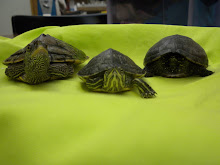Freaky: Hi guys! Yoda and I decided to write this review together, since he usually does nonfiction, and I usually do kids' books, and this is both.
Yoda: To give both perspectives.
Freaky: Right. Whatever that means.
Yoda: We should mention that this book may be of interest to adults as well as children. Not for an in-depth study of any sort, but for some interesting general information.
Freaky: Definitely interesting! I had no idea there were so many different types of schools. I mean, I knew rules were different in other places, and subjects and so on, but a school on a giant raft? Way cool!
Yoda: Ah, yes, the floating schools in Cambodia. Was that your favorite one?
Freaky: No, but my favorite one does float. There's a ship that travels around the world giving people medical care, and a bunch of kids live on it with their parents, so they have a school right there on the ship.
Yoda: Do you think you would get tired of seeing your classmates all day, every day?
Freaky: Maybe. But, I'll bet I could find a place to be by myself if I needed to. Besides, they get to travel to different countries, AND they get to visit with sick kids who are staying in the hospital ward on the ship, and help them get better.
Yoda: I suppose that does beat sitting in front of the television after school.
Freaky: So, which school would you like to go to?
Yoda: I found the virtual school in Egypt intriguing; children allowed to study what they choose, and able to plan their own schedules.
Freaky: Can I be honest here?
Yoda: Certainly.
Freaky: I don't think I'd end up doing much some days.
Yoda: (chuckling) Yes, it would definitely take quite a bit of self-motivation to be successful. The young lady profiled in that section seems to have it, though.
Freaky: Maybe because she had such a hard life before, and so she appreciates it?
Yoda: Very possible. I looked for a web site to see if that was typical of all the school's students, but the only links I came up with were no longer working.
Freaky: Hey, I looked up web sites too! I had better luck, though. I'll put them at the end of our review. The ship I read about was part of something called Marcy Ships. That ship is retired now, but they have an even bigger one with more people on it called the Africa Mercy.
Yoda: It would have been a nice addition to the book to have contact information for some of these schools.
Freaky: Right, like the very first one!
Yoda: In Afghanistan.
Freaky: Yeah! As soon as I read that, I was like, woah, that's not fair! I want to help!
Yoda: You mean because the school they worked so hard to build was destroyed.
Freaky: Right! But I did find a web site, and we'll add that link, too. It was kind of weird to have the book start off with such a heavy one, though.
Yoda: I think it was meant to be encouraging, not sad. They haven't given up, and in fact they have expanded their efforts. Overall, the book is very upbeat, and made us both want to visit or even be a part of some of these schools. Was there anything else you didn't like?
Freaky: Just a little thing. In the part about the United States they talk about home schoolers, which is GREAT, because we have lots of home schooled friends! There was just one sentence where they said all home schoolers have to pass yearly tests, and that's not true for all states.
Yoda: Including ours.
Freaky: Yep! New Mexico doesn't have as many regulations as other states. I think that has something to do with the independent streak passed down from the old pioneers and cowboys. What about you, Yoda, was there anything you didn't like?
Yoda: Well, as I mentioned, this book may be interesting as an overview, but doesn't provide much detail. The side bars for each section give the location and population of each country, but that space might be better served with basic education information - ages of required schooling, types of schools, for example. I can't imagine ALL schools in Egypt are like the virtual school.
Freaky: Is that it?
Yoda: Yes, Freaky, that is "it". Overall I found the book quite enjoyable, and was inspired to do some more research about some of the schools mentioned. As I said, it would have been nice to have a list of web sites or books to reference, but I suppose I can find those on my own.
Freaky: So, two flippers up?
Yoda: Yes, Freaky, two flippers up.
Freaky: You heard it, folks! Here are those web sites we promised:
http://www.saga.co.uk/saga-charitable-trust/ (for the school in Nepal)
http://www.mercyships.org/home
http://www.greenvillageschools.org/main.htm (Afghanistan)
and, here is a link to buy the book:

